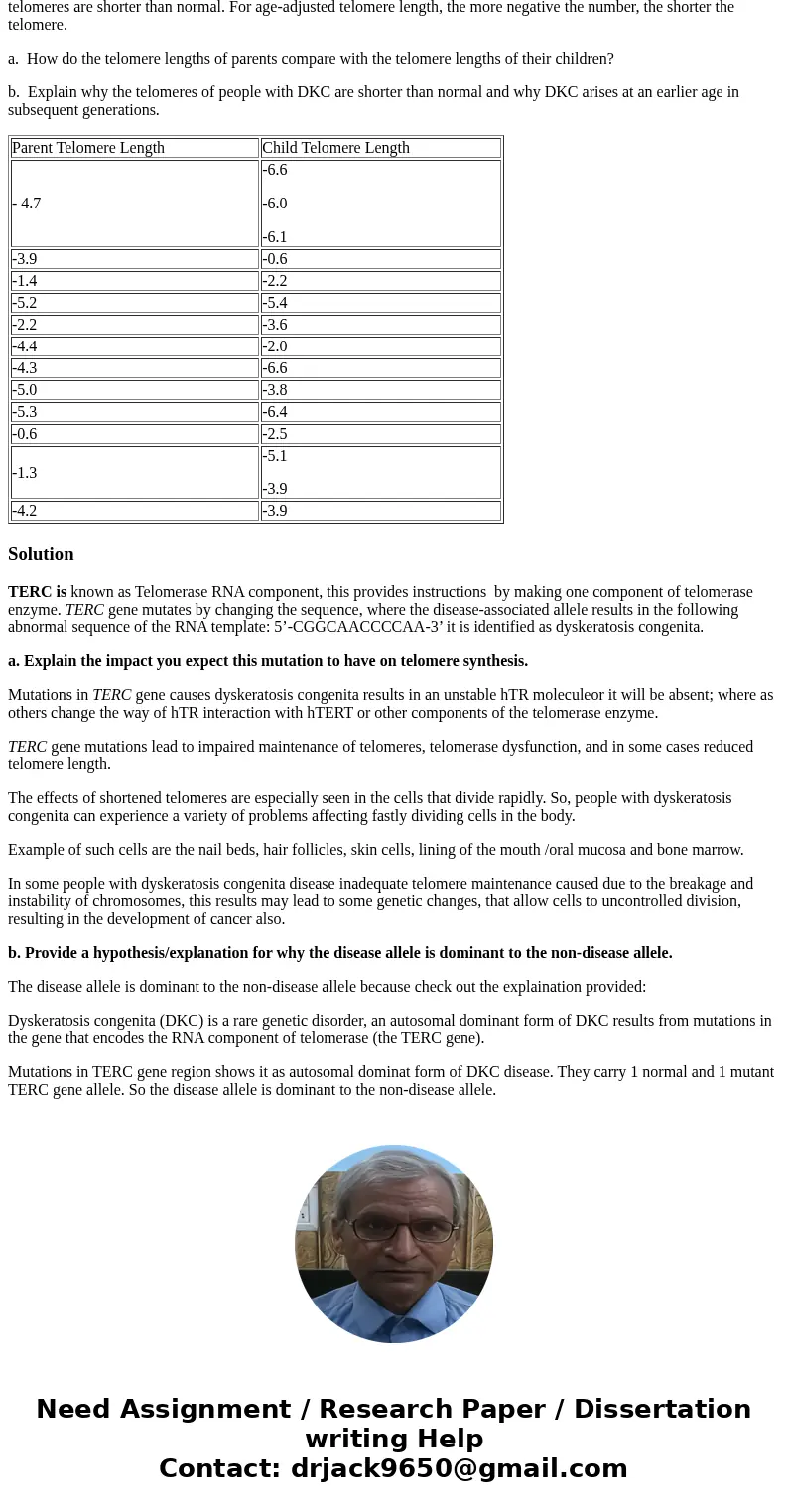66 60 61 51 39 39 The sequence change affecting the TERC gen
-6.6
-6.0
-6.1
-5.1
-3.9
-3.9
The sequence change affecting the TERC gene in each of the families is different. However, consider an example where the disease-associated allele results in the following abnormal sequence of the RNA template: 5’-CGGCAACCCCAA-3’
a. Explain the impact you expect this mutation to have on telomere synthesis.
b. Provide a hypothesis/explanation for why the disease allele is dominant to the non-disease allele.
please explain in detail need real help :( THIS ARE QUESTIONS I NEED THEM ANSWER NOT THE ONE AT THE BOTTOM
If You get confused this second part questions and the background can help.
Dyskeratosis congenita (DKC) is a rare genetic disorder characterized by abnormal fingernails and skin pigmentation, the formation of white patches on the tongue and cheek, and progressive failure of the bone marrow. An autosomal dominant form of DKC results from mutations in the gene that encodes the RNA component of telomerase (the TERC gene). Fifteen families with autosomal dominant DKC are evaluated. The median age of onset of DKC in parents was 37 years, whereas the median age of onset in the children of affected parents was 14.5 years. Thus, DKC in these families arose at progressively younger ages in successive generations. The researchers measured telomere length of members of these families (see table). Telomere length normally shortens with age, so telomere length was adjusted for age of the subject. Note that the age-adjusted telomere length of all members of these families is negative, indicating that their telomeres are shorter than normal. For age-adjusted telomere length, the more negative the number, the shorter the telomere.
a. How do the telomere lengths of parents compare with the telomere lengths of their children?
b. Explain why the telomeres of people with DKC are shorter than normal and why DKC arises at an earlier age in subsequent generations.
| Parent Telomere Length | Child Telomere Length |
| - 4.7 | -6.6 -6.0 -6.1 |
| -3.9 | -0.6 |
| -1.4 | -2.2 |
| -5.2 | -5.4 |
| -2.2 | -3.6 |
| -4.4 | -2.0 |
| -4.3 | -6.6 |
| -5.0 | -3.8 |
| -5.3 | -6.4 |
| -0.6 | -2.5 |
| -1.3 | -5.1 -3.9 |
| -4.2 | -3.9 |
Solution
TERC is known as Telomerase RNA component, this provides instructions by making one component of telomerase enzyme. TERC gene mutates by changing the sequence, where the disease-associated allele results in the following abnormal sequence of the RNA template: 5’-CGGCAACCCCAA-3’ it is identified as dyskeratosis congenita.
a. Explain the impact you expect this mutation to have on telomere synthesis.
Mutations in TERC gene causes dyskeratosis congenita results in an unstable hTR moleculeor it will be absent; where as others change the way of hTR interaction with hTERT or other components of the telomerase enzyme.
TERC gene mutations lead to impaired maintenance of telomeres, telomerase dysfunction, and in some cases reduced telomere length.
The effects of shortened telomeres are especially seen in the cells that divide rapidly. So, people with dyskeratosis congenita can experience a variety of problems affecting fastly dividing cells in the body.
Example of such cells are the nail beds, hair follicles, skin cells, lining of the mouth /oral mucosa and bone marrow.
In some people with dyskeratosis congenita disease inadequate telomere maintenance caused due to the breakage and instability of chromosomes, this results may lead to some genetic changes, that allow cells to uncontrolled division, resulting in the development of cancer also.
b. Provide a hypothesis/explanation for why the disease allele is dominant to the non-disease allele.
The disease allele is dominant to the non-disease allele because check out the explaination provided:
Dyskeratosis congenita (DKC) is a rare genetic disorder, an autosomal dominant form of DKC results from mutations in the gene that encodes the RNA component of telomerase (the TERC gene).
Mutations in TERC gene region shows it as autosomal dominat form of DKC disease. They carry 1 normal and 1 mutant TERC gene allele. So the disease allele is dominant to the non-disease allele.


 Homework Sourse
Homework Sourse